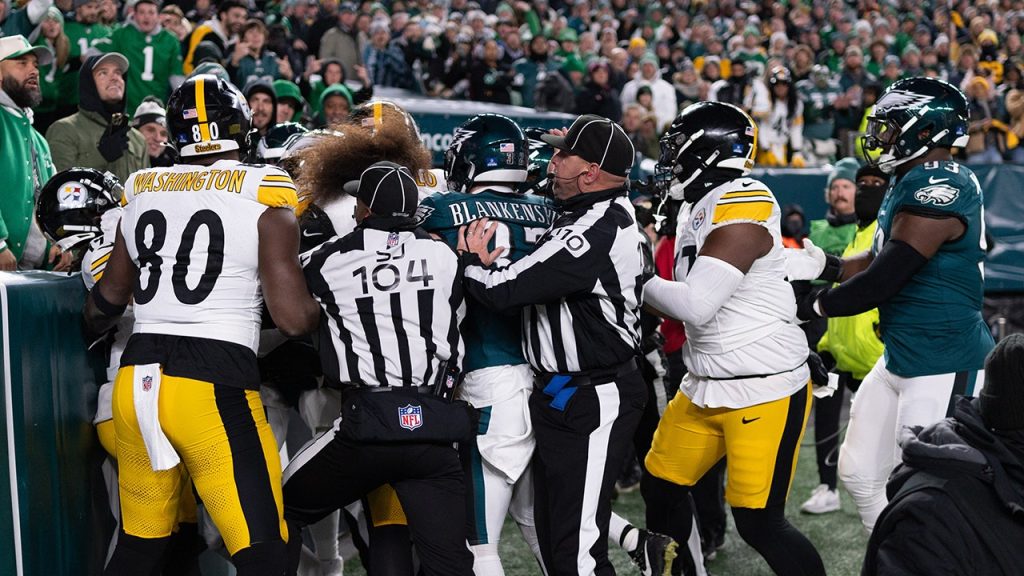The chilly Philadelphia air couldn’t cool the simmering rivalry between the Eagles and the Steelers as the two teams clashed at Lincoln Financial Field on a Sunday evening brimming with playoff implications. The game, a crucial showdown between two Super Bowl hopefuls, quickly ignited with a first-quarter skirmish. Following a play in which Steelers tight end Darnell Washington appeared to block Eagles defensive back Darius Slay into the back of the end zone, players from both sides converged, engaging in a brief but heated exchange of pushing and shoving. The officials intervened, flagging Washington and Steelers wide receiver Calvin Austin III for unnecessary roughness. The Eagles accepted the penalty on Washington, giving them a crucial advantage. Steelers head coach Mike Tomlin, visibly agitated by the officiating, expressed his displeasure to the referees. Pittsburgh salvaged the drive with a 37-yard field goal by Chris Boswell, but the tone for a physically charged contest had been set.
The Eagles, undeterred by the early fracas, responded swiftly. Quarterback Jalen Hurts orchestrated a masterful six-play, 70-yard drive, culminating in a touchdown pass to star receiver A.J. Brown. The score not only put the Eagles ahead but also underscored the potent offensive firepower they possessed, a threat the Steelers defense would have to contend with throughout the game. This rapid response demonstrated Philadelphia’s determination to assert their dominance on their home turf, leveraging the energy of the crowd and the momentum generated by the earlier defensive stand. The touchdown pass to Brown was a testament to the burgeoning connection between the quarterback and his top receiver, a partnership that had faced some scrutiny but continued to deliver crucial plays for the Eagles.
The “Battle of Pennsylvania,” as it’s often called, lived up to its billing, featuring two teams with legitimate Super Bowl aspirations. The Pittsburgh Steelers, boasting a resurgent Russell Wilson and a consistently robust defense, entered the game as strong contenders for the AFC North crown. Their defensive prowess had been a hallmark of their season, and Wilson’s recent performances had injected a renewed sense of optimism into the team’s offensive capabilities. They arrived in Philadelphia determined to prove their mettle against a formidable NFC East rival. The outcome of this game carried significant weight for their playoff ambitions and their quest to secure a coveted spot in the AFC playoffs.
The Philadelphia Eagles, despite navigating some internal controversies surrounding Hurts and Brown, had firmly maintained their grip on the NFC East lead, holding off a persistent challenge from the Washington Commanders. This game represented not only a chance to solidify their divisional standing but also an opportunity to make a statement against a fellow Super Bowl contender. A victory would bolster their playoff aspirations and reinforce their position as one of the NFC’s elite teams. The home crowd provided a raucous backdrop for this crucial encounter, adding to the intensity of the rivalry and the pressure on both teams to perform.
The clash between the Eagles and Steelers highlighted the competitive landscape of the NFL, showcasing two teams with contrasting strengths and weaknesses, both vying for postseason glory. The Steelers’ defensive solidity and Wilson’s rediscovered form pitted them against the Eagles’ potent offense and the dynamic duo of Hurts and Brown. The early-game skirmish and the ensuing touchdown drive set the stage for a hard-fought battle, with both teams aware of the high stakes involved. The game promised to be a physical and emotionally charged affair, with the outcome holding significant ramifications for the playoff picture in both conferences.
This interconference matchup represented a key test for both teams as they sought to solidify their playoff standing. The Steelers aimed to gain ground in the competitive AFC North, while the Eagles aimed to maintain their dominance in the NFC East. The result of this game would not only impact the divisional races but also influence the overall seeding in their respective conferences as the season progressed. The “Battle of Pennsylvania” served as a microcosm of the intense competition and high stakes that characterize the NFL, with every game holding the potential to reshape the playoff landscape and determine the ultimate contenders for the Super Bowl.

